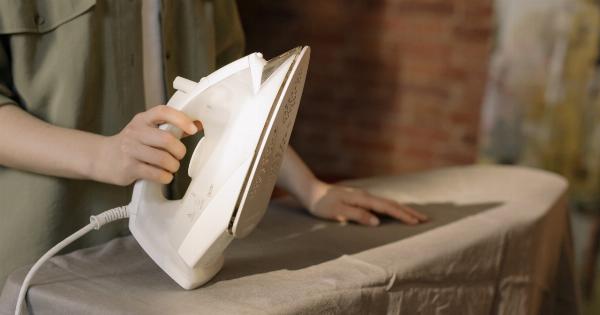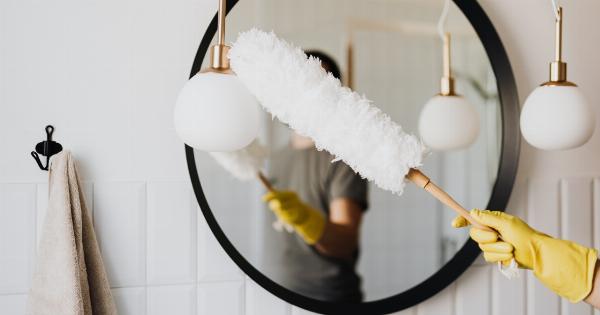Keeping your house clean and germ-free is essential for maintaining a healthy living environment.
While we often focus on obvious areas like toilets and kitchen countertops, there are several other commonly overlooked spots that can harbor harmful germs. In this visual guide, we will explore some of these germy spots and provide tips on how to effectively clean and disinfect them.
1. TV Remote
The TV remote control is one of the most frequently used items in households. From snacking while watching a movie to touching it with dirty hands, it often becomes a breeding ground for germs.
To clean it, use a disinfecting wipe or a cloth dampened with isopropyl alcohol. Make sure to remove the batteries before cleaning. Additionally, consider placing a removable cover over the remote to protect it from contamination.
2. Computer Keyboard
With hours of typing and snacking at your desk, it is not surprising that your computer keyboard can accumulate an alarming number of germs. To clean it, start by turning off your computer and unplugging the keyboard.
Gently shake it to remove loose debris, then use compressed air or a small brush to dislodge any remaining particles. Wipe down the keys and surfaces with a cloth dampened with isopropyl alcohol.
3. Cell Phone
Your cell phone goes everywhere with you and is constantly exposed to different surfaces and environments. Studies have revealed that cell phones harbor more bacteria than a toilet seat.
Clean your phone regularly by using a disinfecting wipe or a cloth dampened with isopropyl alcohol. Avoid using excessive liquid that may damage your phone’s sensitive components.
4. Light Switches
Light switches are touched multiple times a day by everyone in your household, making them a high-traffic germ zone. To clean them, first, turn off the power to the switch.
Then, dampen a cloth or disinfecting wipe with a mild cleaning solution and gently wipe down the switch plate and surrounding area. Remember to dry the switch thoroughly before turning the power back on.
5. Refrigerator Handle
The refrigerator handle is a hotspot for germs, as it is frequently touched, especially during meal preparation. To clean it, use a disinfecting wipe or a cloth dampened with a mild cleaning solution.
Pay close attention to the nooks and crevices where bacteria can hide. Regularly wiping down the handle can help prevent cross-contamination in your kitchen.
6. Bathroom Faucets
Bathroom faucets are exposed to water, soap, and various contaminants, making them a prime breeding ground for bacteria. To clean them, first, turn off the water supply. Then, scrub the faucet and handles with a mixture of warm water and mild soap.
Rinse thoroughly and dry with a clean towel. For hard-to-reach areas, use a toothbrush soaked in the cleaning solution.
7. Doorknobs
Doorknobs are among the most frequently touched surfaces in a house. Cleaning them regularly can help prevent the spread of germs. To clean a doorknob, start by removing any visible dirt or grime with a damp cloth.
Then, disinfect the surface using a disinfecting wipe or a cloth soaked in a mixture of water and bleach. Make sure to wear gloves and properly ventilate the area when working with bleach.
8. Bedding
Many people spend a significant portion of their day in close contact with their bedding. Sweat, dead skin cells, and bodily fluids can accumulate, providing a perfect breeding ground for germs.
Wash your bedding, including pillowcases and sheets, regularly in hot water to ensure proper sanitation. Remember to follow the manufacturer’s instructions for specific cleaning recommendations.
9. Pet Bowls
If you have pets, their food and water bowls can be a haven for bacteria. These bowls should be cleaned regularly to prevent the growth of harmful germs. Wash them with hot water and mild dish soap after each use.
Additionally, consider using stainless steel or ceramic bowls that are easier to clean and less likely to retain bacteria than plastic bowls.
10. Kitchen Sponges
Kitchen sponges are used to clean various surfaces and utensils, but they can quickly become breeding grounds for bacteria due to their porous nature.
To clean and disinfect your kitchen sponge, rinse it thoroughly after each use and wring out excess water. Microwaving a damp sponge for 1-2 minutes or running it through the dishwasher can also help kill germs. Replace your sponge regularly to ensure effective cleaning.




























